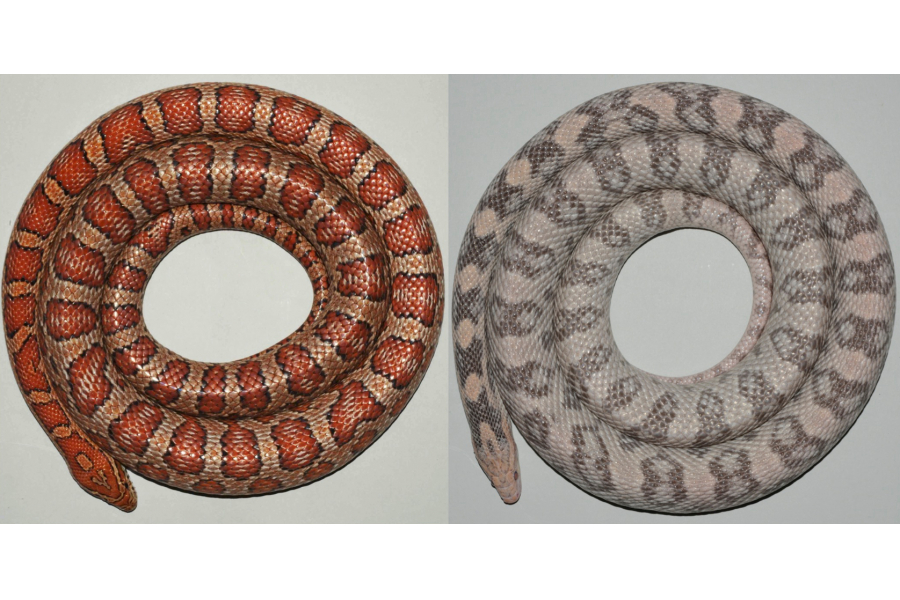- news
- 06-10-2020

The skin colour of vertebrates depends on chromatophores — cells found in the deep layers of the skin. The Milinkovitch lab composed of a team of specialists in genetic determinism and colour evolution in reptiles is studying the wide variety of colours sported by different individuals within the corn snake species. The research, published in the journal PNAS, demonstrates that the dull colour of the lavender variant of corn snake is caused by the muta- tion of a gene involved in forming lysosomes, the “garbage disposal” vesicles of cells. This single mutation is enough to affect every skin colour, demonstrating that both the reflective crystals and pigments are stored in lysosome-related vesicles. This study marks a significant step forward in our understanding of the origin of colours and patterns in the skin of vertebrates.
The chromatophores are the cells that determine skin colour, thanks to the presence of pigments or crystals that reflect light. There are three types of chromatophores: melanophores, which are responsible for the black or brown colour; xanthophores, for red and yellow; and iridophores, with crystals that reflect multiple colours. Mammals only have melanophores, while reptiles and fish carry all three types of chromatophore, meaning they can display a very wide variety of colours and colour patterns. The pigments of melanophores are known to be stored in organelles known as LROs or lysosome-related organelles. These are small intracellular vesicles that have the same origin as lysosomes, the “garbage disposals” that digest the non-functional molecules in cells. On the other hand, the storage location of the red and yellow pigments and crystals in the other types of chromatophore is unknown.
When snakes turn pink
The skin of corn snakes (Pantherophis guttatus) has an orange base, decorated with red dorsal and lateral spots circled in black. The spe- cies can undergo mutations that lead to variations in skin colour, with the lavender corn snake being pink with grey spots. The experiments carried out by Athanasia Tzika, a researcher in the Department of Genetics and Evolution in UNIGE’s Faculty of Sciences and her doctoral student Asier Ullate-Agote have identified that these altered colours are due to a single mutation pinpointed in the LYST gene, a gene that regulates lysosome trafficking. “It’s very long-term work”, begins Tzika, “since snakes only have one litter a year. Also, we had to sequence the entire genome of the corn snake and identify all the genes within”.
The liver is key
Mutations in the LYST gene in humans cause the Chediak-Higashi syndrome, which is characterised by albinism, an impaired immune system and an accumulation of enlarged lysosomes. The Geneva team continued its study into corn snakes by analysing their hepatocytes, the main liver cells in vertebrates, which contain numerous lysosomes. The scientists found that the hepatocytes of lavender corn snakes contain much larger and more aggregated lysosomes. Using electron microscopy, the authors observed that the morphology and arrangement of coloured vesicles in all the chromatophores were altered.
The result of evolution
Michel Milinkovitch, a professor in UNIGE’s Department of Genetics and Evolution, explains further: “By characterising the mutant gene, the study has shown for the first time that the different chromatophores were not created from scratch during evolution but that they all entail a basic mechanism involving LROs”. Further studies will provide a better understanding of the mechanisms responsible for the extraordinary variety of skin colours and colour patterns in vertebrates, features that play a part in functions as diverse and essential as camouflage, intraspecific communication, and protection against the harmful effects of solar radiation.
Reference
Genome mapping of a LYST mutation in corn snakes indicates that vertebrate chromatophore vesicles are lysosome-related organelles
Ullate A, Burgelin I, Debry A, Langrez C, Montange F., Peraldi R, Daraspe J, Kaessmann H, Milinkovitch MC and A. C. Tzika*
*Corresponding author: Athanasia Tzika
PNAS, October 5 2020
